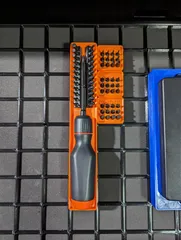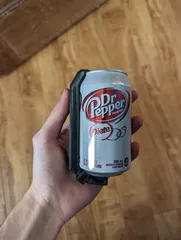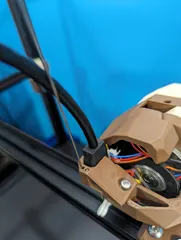Updated bicycle brake rotor truing tool
Description
PDFUpdated the original to fit this cheap Amazon dial indicator. Also made it wider to support 203mm rotors and added a new contact surface that uses a 12mm bearing to prevent the indicator tip from getting caught in the rotor. The ball bearing works very well, but at the very least you should use the plastic pad from the original - using the bare indicator will probably be a bad time.
I've included the STEP files if you need to adapt it for different brakes, indicators, or ball bearings. This system seems to work well and is more repeatable than I had expected!
Printing
I used PETG for the bearing holder for a little flexibility in the press fit, but PLA will probably be fine. I used PLA for the main indicator holder for rigidity.
Supports (read this part)
This part is a pain in the ass to support so I've included a version with built-in supports to allow for a full bridge on all overhangs. The supports can be trimmed off after printing.
Settings
- Bearing holder - 0.16mm, 25% infill
- Indicator holder - 0.2 or 0.28, 25% infill, 4 perimeters. Print in the orientation provided (caliper mounts oriented vertically)
Assembly
Put the indicator in the hole and secure it with an m3 machine screw + nut (or heat-set insert). Don't over-tighten.
If using the bearing holder, press-fit the bearing into the holder's cup then press that assembly onto the dial. You may want use a 5mm drill bit to ensure the bore diameter is correct or possibly oversize it a bit before printing. Holding the backside of the indicator tip, press it onto the indicator.
Usage
Remove your brake caliper and put it somewhere that won't get tangled up in the spokes. Mount the indicator holder on the caliper posts and adjust it so that the indicator rests on the pad contact area of the rotor. Adjust and zero the indicator as-needed and spin the wheel to see where it needs adjustment.
Tips:
- Don't stress perfection - a ~5 thou (0.127mm) range is more than good enough and should be achievable in under 5 minutes
- I have a bike stand, but I found it way more ergonomic to flip my bike upside down and rest it on the floor. Makes getting at the calipers easier, especially on the front
- Be patient and make small adjustments as to not actually bend your rotor in a bad way
- While most rotors have holes for heat dissipation, usually you can find a slim region of continuous metal somewhere on the braking region. Getting your indicator in that range makes things a lot easier
- If you don't have a rotor bending tool, an adjustable wrench (Crescent wrench) with smooth, parallel jaws works great
- I really, really liked the way the ball bearing indicator tip worked out. If you have bearings but not in 12mm, I recommend modifying the included step files to fit yours. This is untested and rotor-dependent, but my gut feeling is that 8-10mm would be the smallest you'd want
Tags
Model origin
The author remixed this model.





